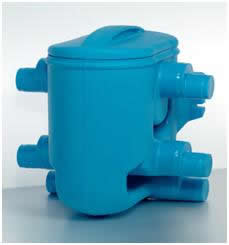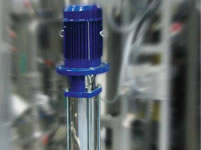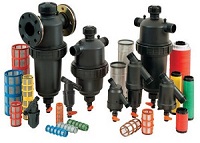Direct Collection System:
The simplest and most cost effective way of collecting rain water from a roof is simply to direct the rain gutters directly over the side of a water storage tank.
Using this method cuts out the need to use power to pump water from a sump…gravity is sufficient.
If the roof is sited where leaves, straw, or moss are likely to be washed down the gutters, simple prefiltration is desireable in order to keep organic detritus and thus pathogens (eg Phytophthora and Pythium) out of the tank. Either simply screen the gutter/down pipe orifice with a coarse mesh, then clean regularly or install screen filters on the down pipes. This necessitates sufficient differential in height between gutter and tank lip. (see photo)

Case study from Equine Buildings:
The remit was to collect rain water from college equine buildings and recycle it through an irrigation system in order to damp down the menage. A simple dust suppression system.
The Numbers:
- Roof area for collection 60m x 27.3m (1632m²)
- Annual Precipitation Rate 4mm (16”)
- Annual Potential Yield 653m³
- Yield from a 1” rainfall event 41m³
In this case, convenient space to site a tank was limited. A 50m³ tank was installed.
This is sufficient to hold more than a 1” rainfall event.
If a 5mm coverage of the menage arena is required, then 6m³ of water is applied.
This means the 1” rain event that can be collected is sufficient to water the menage up to 8 times. Since the tank was fully replenished every time 1 ¼” rain fell then rainwater generally provides sufficient for this purpose.
The System:
- Erect a 50m³ (15’ x 10’) galv. tank with liner and cover.
- Divert gutter down pipes to the lip of the tank.
- Insert overflow in top of tank back to drains
- Pump from the tank to sprinklers’ storage tank and inhibit water into this tank from the mains.
Costs:
The cost of the 50m³ Tank, pump and pipe work - £ 4000
Additional cost of tank erection and pipe work installation plus groundworks to be added.
Depending upon how much water the college can use thru this system and for allied functions in the equine buildings the capital payback might be 7-10 years. In this case the volume collectable is not equalled by the demand and so the payback is longer than is often the case.




